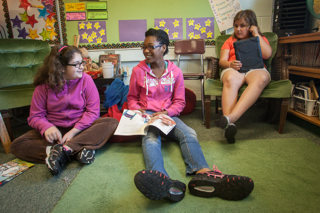Transitions and Getting Student Attention
Join Our Community
Access this resource now. Get up to three resources every month for free.
Choose from thousands of articles, lessons, guides, videos, and printables.
What's your favorite tried and true attention signal? Mine is a golden oldie that my Daddy used to sing it to me, "Shave and a haircut." Then I would sing in reply, "Two bits." The tune is only a seven-note jingle, but it is mighty. I teach this to my students on the first day of school. I sing the first part; they sing the second. When they hear that tune, my students know that I have something they need to know. It's time to get quiet quickly and listen.
 The advantage of singing is that the tone and rhythm cut right through almost any noise. I can sing this at lively class parties and children will get quiet immediately. Parents are always amazed and think I'm some sort of child whisperer. One reason I think this works is that it is gentle and pleasant sounding.
The advantage of singing is that the tone and rhythm cut right through almost any noise. I can sing this at lively class parties and children will get quiet immediately. Parents are always amazed and think I'm some sort of child whisperer. One reason I think this works is that it is gentle and pleasant sounding.
I also use this jingle during sharing time. Same tune, but I change the words a bit. If the children are losing focus I will sing, "Where is my audience?" or "I need an audience." The children sing back, "Right here!" This can help center the attention on the writer and buy a few more minutes of share time.
This year I have a bit rowdier crowd and found that not everyone was hearing me the first time. I started singing the jingle twice. Big mistake. Some students would not even begin to listen until I had sung it two times. So I made a few changes. Now I'll sing it once and point to the children who sang back and say "Thank you for being a first time listener." Now we're all getting back on track.
If you are interested, here are a few other behavior management tricks I use during share time:
- Be sure you have labeled, modeled and practiced what a good listener looks like.
- Be animated and quick.
- I often say, "Point to the person whose turn it is to talk." They point to the sharer and I say, "Yes, you are right, thanks for listening."
- Ask students to "notice" things about the sharer's writing.
- Try complimenting who is listening.
- Make connections between students about their writings. They listen better if they hear how their writing is like their neighbors.
- Remind students of the Golden Rule. If you want your friends to listen to you; now it's time for you to listen to them.
- If it's just one or two offenders I might say, "Does Mrs. Prentice want you to talk right now, yes or no.?" When they say no, I will say, "You are correct, let's get busy listening."
- Sometimes, if it's one of "those" days, it's best to quit and finish up after lunch.
Can I promise your sharing times will always run smoothly? Will the children always respond and listen quietly? Unequivocally no! But does anything run perfectly in a classroom all the time? I believe that students' sharing their work is the most important instructional strategy a teacher can use. It's worth the effort! This can be the glue that binds a classroom community together and it only costs two bits!






